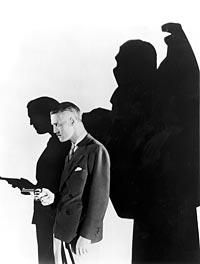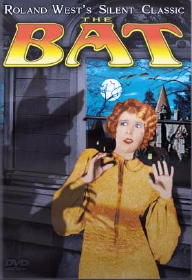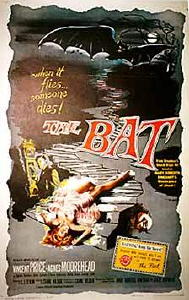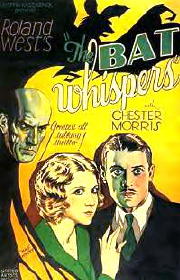Mon 19 Mar 2007
Mary Roberts Rinehart’s THE BAT, by Michael Grost and Mary Reed.
Posted by Steve under Authors , Characters , Mystery movies , Mystery plays[16] Comments
Mary Roberts Rinehart’s character called “The Bat” appeared in many formats over the years. Not only did “The Bat” make a lasting impression and appear in many venues, but Bob Kane, creator of the second most famous comic book character, the Batman, has been quoted as saying that the inspiration for his hero came from “actor Douglas Fairbanks’ movie portrayal of Zorro, and author Mary Rinehart’s mysterious villain ‘The Bat.’”

This post has been put together from a variety of sources, the first being Michael Grost’s Classic Mystery and Detection website, from which is gleaned the following information about the early career of mystery author Mary Roberts Rinehart:
The career of Mary Roberts Rinehart (1876-1957) can be broken up into a series of phases. The first was her pulp period (1904-1908), where she wrote her first three mystery novels and a mountain of very short stories. These stories have never been collected in book form, and are inaccessible today. The first two novels are classics, however, and are probably her best works in the novel form.
The Man in Lower Ten (1906) and The Circular Staircase (1907) are the earliest works by any American author to be still in print as works of entertainment, not as “classics” or “literature.” These novels, which combine mystery and adventure, show Rinehart’s tremendously vivid powers as a storyteller.
From the same page, but skipping over a few sections:
The Bat is a stage adaptation of Rinehart’s The Circular Staircase, written in collaboration with Avery Hopwood, the writer of popular Broadway comedies with whom Rinehart had collaborated before. The Bat introduced some new plot complexities into the original novel, especially a master criminal known as “The Bat.” It also includes plot elements reminiscent of her first Saturday Evening Post story, “The Borrowed House” (1909). The Bat shows Rinehart at the height of her powers, and in fact is her greatest work. A work of great formal complexity, The Bat is one of the few mystery stage plays to have the dense plotting of a Golden Age detective novel. Moreover, the formal properties of the stage medium are completely interwoven with the mystery plot, to form intricate, beautiful patterns of plot and staging of dazzling complexity.
According to the online Broadway database, The Bat ran for 867 performances between August 23, 1920 and September 1922.
Film director Roland West next made two versions of the play, a silent film The Bat (1926), and a sound film The Bat Whispers (1930).
Following the links will lead you to the IMDB pages for each.

His discussion is far too lengthy to repeat here, but Mike Grost goes into considerable detail in discussing director Roland West’s cinematic techniques in both of these movies, plus a number of his other films. If you’re interested in the early days of movie making, Mike’s website once again is well worth the visit.
Returning to the play itself, Mike continues by saying:
It should also be noted that the play itself was later published by French, in a 1932 softcover edition.
In 1959 The Bat was once again made into a film, this one starring Vincent Price and Agnes Morehead. Of this version, one viewer says: “I found this to be an inventive and disingenuous endeavor full of red-herrings and wrong turns. Figure this one out for yourself. Puzzle the clues, weed out the characters set here as distractions, look past the deliberate contrivances and solve the mystery on your own.”

By total coincidence, the way coincidences happen, as I was in the process of tracking down the details of all these various incarnations of the character, author Mary Reed sent me the following review of The Bat, the novel based on the play. I think it’s great when a plan comes together like this.
Review of THE BAT: The Novel, by Mary Reed
Everyone in the city, from millionaires to the shady citizens of the underworld, goes in fear of The Bat, a cold-blooded loner whose crimes range from jewel theft to murder and whose calling card is a drawing or some other form of expression of bathood.
We meet wealthy, elderly, and independent spinster Miss Cornelia Van Gorder, scion of a noble family and the last of the line. An adventurous spirit, at 65 and comfortably situated, she still longs for a bit of an adventure. It maddens her to think of the sensational experiences she is missing as she contemplates that “…out in the world people were murdering and robbing each other, floating over Niagara Falls in barrels, rescuing children from burning houses, taming tigers, going to Africa to hunt gorillas, doing all sorts of exciting things!” Why, she’d love to have a stab at catching The Bat!
Her wish is granted when she takes a house in the country for the summer and discovers it is located some twenty miles from an area where The Bat had committed three crimes. She is soon in the thick of mysterious events, including anonymous threatening letters, lights failing, a face at the window, and Lizzie Allen, her personal maid for decades, convinced she saw a strange man on the stairs. Most of the servants decamp, leaving Miss Van Gorder to manage with just a butler and Lizzie.
More characters appear: Miss Van Gorder’s niece Dale Ogden, Brooks, the new gardener, local medical man Dr Wells, Detective Anderson, and Richard Fleming, nephew of Courtleigh Fleming, deceased owner of the house and once president of a bank which has just failed. There is talk Mr Bailey, its cashier, has stolen over a million dollars. A man is shot and an unknown party is deduced to be hiding somewhere on the rambling premises. More than one person in the house is concealing facts, and the rising storm outside underlines the increasing fear and tension within.
Who is trying to scare Miss Van Gorder away and why? What if anything did Lizzie see on the staircase? Are any of the strange goings-on connected with the missing money? Who fired the shot? There is much flitting in and out of the doors and windows of a living room lit most of the time only by candle and firelight before everything is cleared up.
The Bat is an excellent example of an old dark house mystery, with enough obfuscation to keep the reader guessing, although one or two surprises are less well concealed. The menacing atmosphere events create in the house is conveyed and sustained well. I found it a light, diverting read which held the interest without taxing the attention too much. The Bat is an excellent cold-night-outside read, and indeed, although I know whodunit, I would not mind seeing the play!

Etext at http://www.gutenberg.org/dirs/etext00/thbat10.txt
September 21st, 2010 at 10:02 am
When I was very small (I’m 56 now) I saw part of a television adaptation of The Bat before I was made to go to bed by my parents. I would give anything to see it again/all the way through. In those days there were lots of drama anthology shows on television. I wonder if you have any idea what the program could have been. I have all the movie versions — the Vincent Price/Agnes Moorehead one, surprisingly, is by far the least interesting. The silent is probably the best.
November 2nd, 2010 at 9:33 am
..i too am curious about the same show.
I am also your age. I thought
it was non the Kraft mystery theater
program..but program lists for the early
60’s do not list “the bat” let me know
if you find where it is on the net. mike
May 24th, 2011 at 2:24 pm
I wonder if what you saw was an episode of Broadway Television Theatre? http://www.imdb.com/title/tt0532438/ lists “The Bat” appeared on 23 November 1953. The series appeared on channel 9 WOR-TV.
Hope this helps,
Darci
September 28th, 2011 at 8:52 pm
.it was not this program was shown in 59 or early 60. i was born in 55. i’m sure it’s outthere somewhere.
October 31st, 2011 at 12:05 am
The Dow Hour of Great Mysteries had “The Bat” on it’s short series in the early 1960’s and I would love to see it again. I believe “The Cat & the Canary” was also part of this.
January 20th, 2012 at 11:41 am
I saw the vincent price version in the show when I was twelve, and the movie transfixed me. It was my introduction to the sub-genre of dark, old house mysteries, a type of fiction and film I continue to love. I think its popularity has to do with the fact that a house can engulf us, enclose us. We’re part of the scary bits, but, obviously, there is the peripheral real world outside the narrative where we are safe. Boundaries, the layout and borders of a home, can be comforting. We’re in on the events, vulnerable to mystery and terror, but we,also, benefit in the role of reader.
February 9th, 2012 at 10:31 pm
What is/are “Evil’s Four Hundred?” from the Bat novel?
I’ve just discovered this amazing writer!
April 26th, 2014 at 6:24 pm
i have an original photo from dec 1920 of scene 2 of THE BAT at the princess theatre in chicago with entire cast id’d . let me know if you would like a scan for your website-dennis from toledo
April 26th, 2014 at 7:43 pm
Yes, please, and thanks!
April 30th, 2014 at 12:34 pm
April 30th, 2014 at 12:35 pm
For some reason, I can’t seem to be able to edit the post itself to include this photo, so for now I’ll have to be content to leave it here in the comments.
Thanks again, Dennis!
January 13th, 2015 at 2:49 pm
Would you be able to tell me how I can find The Bat” screenplay? Thank you. James
January 13th, 2015 at 4:03 pm
Perhaps this will do:
http://www.samuelfrench.com/p/9288/bat-the
November 9th, 2019 at 7:16 pm
Does anyone happen to know where (and how) to find the original script for the play?
(This would be from 1920.)
The Samuel French version (see comment #13 above) and the University of Pittsburgh version (https://digital.library.pitt.edu/islandora/object/pitt%3A31735037970435/viewer#page/8/mode/2up) are later, and apparently not in the public domain.
Thanks very much…L.
November 9th, 2019 at 7:28 pm
Louise
Hopefully someone who knows more than I will read this and let us both know!
April 11th, 2022 at 4:56 pm
I second Louise’s question from a few years back! Does anyone know of an existing copy of the original 1920 script? Haven’t been able to turn up anything other than versions that are still under copyright, such as the U Pitt 1945 version or later Samuel French editions..